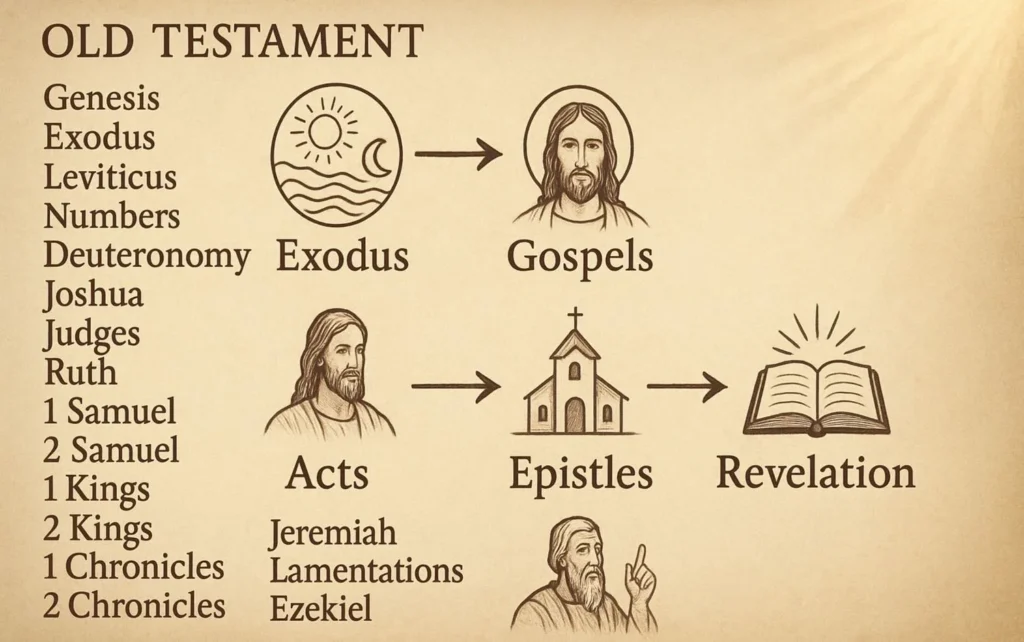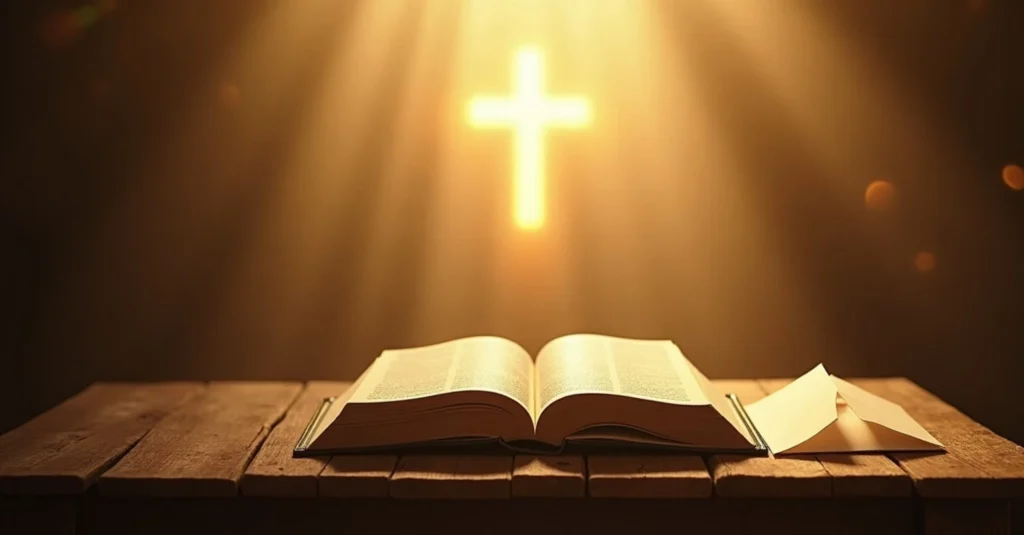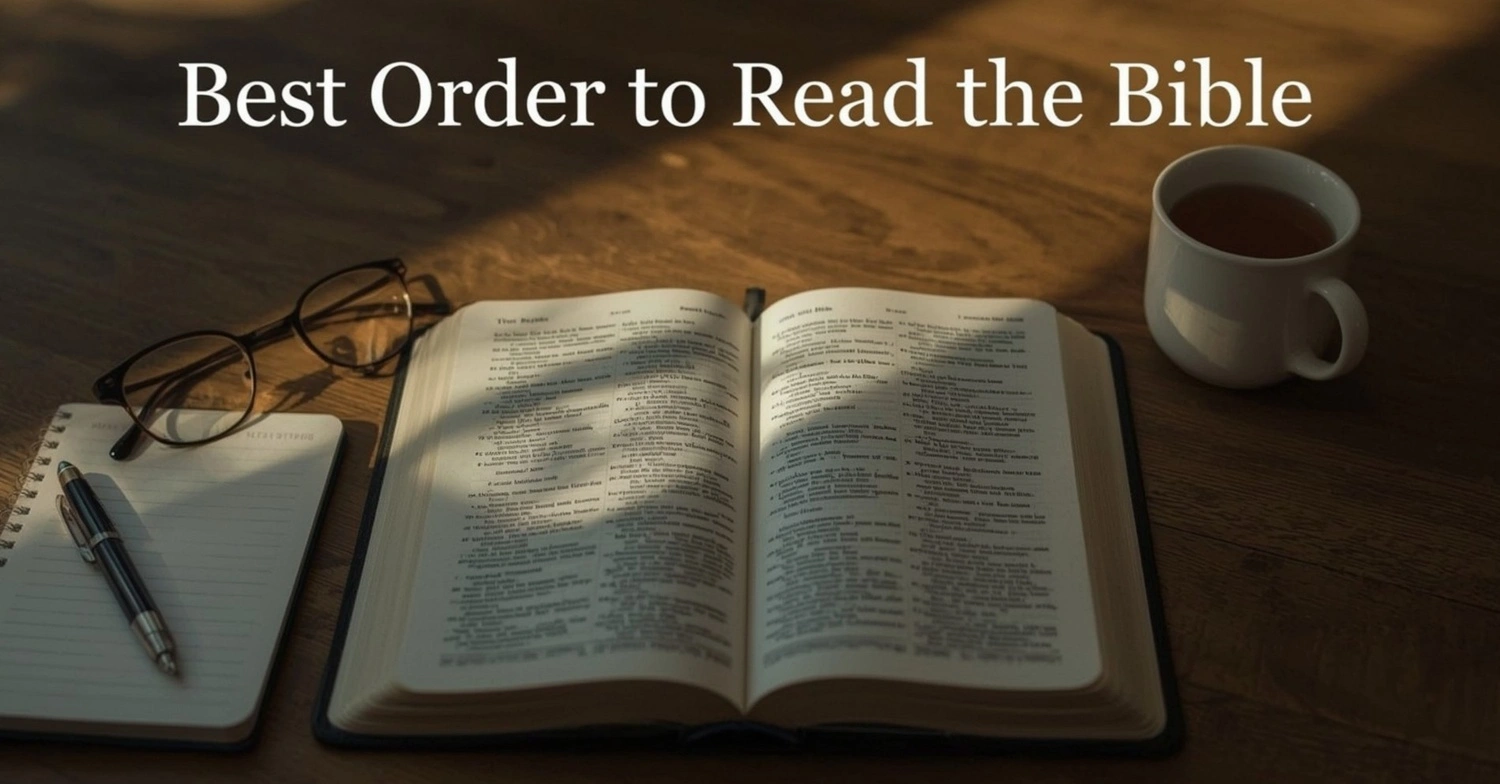Why Knowing the Best Order to Read the Bible Matters
Reading the Bible can feel big and confusing. With 66 books and over 1,100 chapters, it’s easy to feel lost and not know where to start. That’s why knowing the best order to read the Bible is so helpful it gives you a clear path and makes the journey simple and meaningful.
Many people feel overwhelmed when they open the Bible. You might start reading Genesis and suddenly get stuck on long lists, laws, or stories that seem hard to understand. It can feel frustrating, and sometimes, it even makes you want to give up.
But there’s good news: you don’t have to read it all in order from start to finish. With the right approach, you can enjoy the stories, learn about God’s love, and grow in faith step by step.
This guide will help you read the Bible with confidence. You will discover a simple, practical order that makes sense for beginners, for those who want to understand better, and even for Catholics following tradition. Follow this guide, and you’ll find reading the Bible easier, more joyful, and closer to your heart.
Best Order to Read the Bible for Beginners
Starting to read the Bible for the first time can feel confusing. You might open it and see so many books and chapters that you don’t know where to begin. The good news is, you don’t have to read everything in order. Following a simple Bible reading plan for beginners can help you enjoy the stories and understand God’s message without feeling overwhelmed.
Start with the Gospels: John → Matthew → Mark → Luke
A great place to begin is the life of Jesus. Start with John because it is simple and easy to understand, yet full of meaning. Then read Matthew, Mark, and Luke to see the full story of Jesus’ life, His teachings, and the love He shows to everyone.
Reading the Gospels first helps you build a strong foundation of faith. You will get to know Jesus personally, which makes reading the rest of the Bible more meaningful.
Then Acts & Epistles: Romans, Ephesians, Philippians
After the Gospels, move to the Book of Acts. It shows how the first believers shared God’s message and grew the early Church. Then read Paul’s letters like Romans, Ephesians, and Philippians. These letters explain why Jesus’ teachings matter in our daily life and how we can live by faith.
This step helps you understand the “why” behind your faith, not just the stories. It’s about building a relationship with God, not just ticking off chapters.
Old Testament Later: Genesis, Exodus, Psalms, Proverbs
Once you feel comfortable with the New Testament, start exploring the Old Testament. Begin with Genesis and Exodus to learn about creation, God’s promises, and His faithfulness. Psalms and Proverbs are great for daily prayer and wisdom.
Reading the Old Testament after the Gospels makes it easier to understand the stories and see how God’s plan unfolds through history.
Chronological Order to Read the Bible
If you want to understand the Bible as a story that unfolds over time, reading it in chronological order can be very helpful. Following a chronological order to read the Bible helps you see how God’s plan develops from creation to the promises fulfilled in Jesus.
Old Testament Timeline: Genesis → Exodus → Joshua → Judges → Ruth → Samuel → Kings → Psalms → Prophets
Start with Genesis and Exodus to learn about creation, the first people, and God’s covenant with His children. Then read Joshua, Judges, and Ruth to see how God led His people and showed His faithfulness.
Next, move to 1 & 2 Samuel and 1 & 2 Kings to learn about the kings of Israel and how God’s prophets guided them. Psalms and Proverbs give wisdom, prayers, and encouragement along the way. Finally, read the prophets like Isaiah, Jeremiah, and others to understand God’s heart and messages during difficult times.
This order lets you follow the history of God’s people and understand His promises in context.

New Testament Timeline: Luke → Acts → Epistles → Revelation
After the Old Testament, read the New Testament to see God’s promises fulfilled. Start with Luke to learn about Jesus’ life and ministry. Then read Acts to see how the early Church spread God’s message.
Paul’s letters, like Romans and Ephesians, explain how to live by faith and apply Jesus’ teachings in daily life. End with Revelation, which ties everything together and gives hope for the future.
Reading the Bible in this timeline shows the bigger picture of God’s plan, making each story, promise, and teaching more meaningful.
Best Order to Read the Bible in a Year
If you want to read the whole Bible in a year, having a clear plan can make it easier and more enjoyable. Following the best order to read the Bible in a year helps you balance the Old and New Testaments while growing spiritually every day.
Daily/Weekly Plan Example: Genesis + Matthew + Psalms + Proverbs
A simple daily plan can include a little from different parts of the Bible:
- Start with Genesis to learn about creation and God’s promises.
- Read a chapter from Matthew to understand Jesus’ life and teachings.
- Add a few verses from Psalms for prayer and encouragement.
- Include a short reading from Proverbs for daily wisdom.
This mix keeps your reading balanced, encourages reflection, and helps you see how the Old Testament and New Testament connect.
Tips for Consistency: Don’t Worry About Finishing in 12 Months
The goal is not to rush or stress about finishing exactly in a year. What matters most is building a habit and growing in faith. Even if it takes 14–18 months, reading consistently will help you understand God’s Word more deeply.
- Set a regular time each day for reading.
- Reflect on what you read; don’t just finish chapters.
- Pray as you read and ask God to guide your understanding.
Suggested Resources to Help You Read the Bible
Sometimes, having a simple plan can make reading the Bible every day much easier. Here are a few resources that many beginners and regular readers find helpful:
- One-Year Bible Reading Plan – Divides the Bible into manageable daily readings, helping you see a little of the Old Testament, New Testament, Psalms, and Proverbs each day.
- Bible in 52 Weeks – A weekly plan that is easy to follow, perfect if you prefer to read a few chapters at a time.
- Printable Bible Reading Guides (PDF) – These guides are great if you want something you can keep on your desk or carry around. They make it simple to track your daily progress and stay consistent.
Using these resources can make your Bible reading more structured and less overwhelming. They help you stay on track, understand the story of God’s Word step by step, and enjoy the journey rather than rushing to finish.
Best Order to Read the Bible – Catholic
For Catholics, reading the Bible is not just about finishing chapters; it’s about growing closer to God and following His Word within the Church’s tradition. Knowing the best order to read the Bible Catholic can help you understand Scripture more fully and connect it to daily life and faith practices.
Start with Gospels → Acts → Epistles → Old Testament → Deuterocanonical Books
Catholic readers often begin with the Gospels to focus on the life and teachings of Jesus. After that, read Acts to see how the early Church spread God’s message. Then, explore the Epistles to learn how faith applies to daily life.
Once you are familiar with the New Testament, move to the Old Testament to understand God’s promises, His covenant, and His faithfulness through history.
Finally, include the Deuterocanonical books, which are unique to the Catholic Bible. These books enrich your understanding of God’s plan and offer inspiring stories of faith, courage, and wisdom.
Recommended Deuterocanonical Books
- Tobit
- Judith
- Wisdom
- Sirach
- Baruch
- 1 & 2 Maccabees
These books provide spiritual insights and lessons that complement the rest of Scripture, helping you grow in devotion and understanding.
Align Reading with the Liturgical Calendar
Many Catholics find it helpful to read Scripture in harmony with the Church’s liturgical seasons. This means pairing daily or weekly readings with the Mass calendar, which brings God’s Word to life in the rhythm of the Church year.
Following this order makes Bible reading more meaningful and spiritually enriching, helping you see how God’s story unfolds from the Old Testament to the New Testament and through the Church today.

Best Bible Versions for First-Time Readers
Choosing the right Bible version can make a big difference, especially if you are reading for the first time. Picking a version that is easy to understand helps you enjoy the stories, teachings, and wisdom without getting confused. This is one of the most important steps in finding the best way to read the Bible for better understanding.
Recommended Versions: NIV and NLT
- NIV (New International Version): Accurate to the original texts, but easy to read. It’s like having a smart friend explain God’s Word in simple language.
- NLT (New Living Translation): Even simpler to understand, focuses on meaning rather than word-for-word translation. Great for beginners or anyone who wants the Bible to feel approachable.
These versions help you connect with Scripture naturally and understand God’s message without struggling with old or complex language.
Avoid KJV Initially
The King James Version (KJV) is beautiful and poetic, but its language is old-fashioned, with words like “thee” and “thou.” For first-time readers, this can make reading frustrating and hard to follow. It’s better to start with NIV or NLT and explore KJV later when you are more comfortable with Bible reading.
Tips for Choosing a Physical Bible
- Large Print: Easier to read and less strain on the eyes.
- Portable Size: Lightweight Bibles are easy to carry and read anywhere.
- Study Edition for Beginners: Contains notes, explanations, and references to help understand the context.
Choosing the right Bible version and format can make your reading consistent, joyful, and more meaningful.
FAQs: About Best Order to Read the Bible:
Q1. Is there any correct way to read the Bible?
There isn’t one single way. You can read step-by-step, follow a thematic plan, or read in chronological order. Choose the approach that helps you connect with God’s Word daily.
Q2. What part of the Bible should I start reading first?
Start with the Gospels, especially John, to learn about Jesus’ life, teachings, and love. This gives a strong foundation for understanding the rest of the Bible.
Q3. Why is Matthew 17:21 missing from the Bible?
Some Bible manuscripts do not include this verse. Differences like this are called textual variants, but the message of faith and prayer remains clear.
What word is said 365 times in the Bible?
The phrase “Fear not” or “Do not be afraid” appears often, reminding us daily to trust God, stay courageous, and rely on His protection.
Conclusion: Start Your Bible Reading Journey Today
Reading the Bible can feel overwhelming, but the key is to start somewhere and stay consistent. Whether you follow a plan for beginners, a chronological order, or read through the year, what matters most is growing closer to God and building a relationship with Him.
Remember, it’s not about finishing quickly or checking off chapters. Take time to reflect on what you read, pray over it, and let God’s Word guide your daily life. The best order to read the Bible is the one that helps you understand, connect, and experience His love every day.
So pick a starting point, stay faithful in reading, and enjoy the journey of discovering God’s promises, wisdom, and guidance through Scripture. Your heart and spirit will grow as you spend time in His Word consistently.
“Discover the life-changing benefits of daily Bible reading and how it can deepen your faith in God.”

